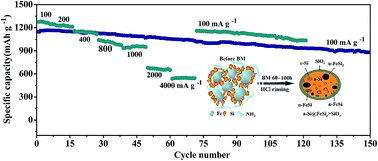A hybrid Si@FeSiy/SiOx anode structure for high performance lithium-ion batteries via ammonia-assisted one-pot synthesis†
Abstract
Synthesised via planetary ball-milling of Si and Fe powders in an ammonia (NH3) environment, a hybrid Si@FeSiy/SiOx structure shows exceptional electrochemical properties for lithium-ion battery anodes, exhibiting a high initial capacity of 1150 mA h g−1 and a retention capacity of 880 mA h g−1 after 150 cycles at 100 mA g−1; and a capacity of 560 mA h g−1 at 4000 mA g−1. These are considerably high for carbon-free micro-/submicro-Si-based anodes. NH3 gradually turns into N2 and H2 during the synthesis, which facilitates the formation of highly conductive FeSiy (y = 1, 2) phases, whereas such phases were not formed in an Ar atmosphere. Milling for 20–40 h leads to partial decomposition of NH3 in the atmosphere, and a hybrid structure of a Si core of mixed nanocrystalline and amorphous Si domains, shelled by a relatively thick SiOx layer with embedded FeSi nanocrystallites. Milling for 60–100 h results in full decomposition of NH3 and a hybrid structure of a much-refined Si-rich core surrounded by a mantle of a relatively low level of SiOx and a higher level of FeSi2. The formation mechanisms of the SiOx and FeSiy phases are explored. The latter structure offers an optimum combination of the high capacity of a nanostructural Si core, relatively high electric conductivity of the FeSiy phase and high structural stability of a SiOx shell accommodating the volume change for high performance electrodes. The synthesis method is new and indispensable for the large-scale production of high-performance Si-based anode materials.


 Please wait while we load your content...
Please wait while we load your content...